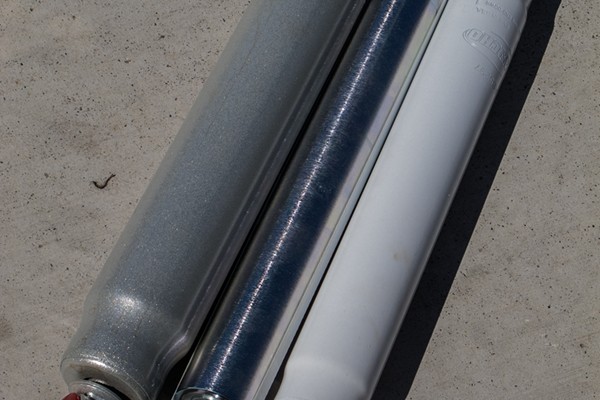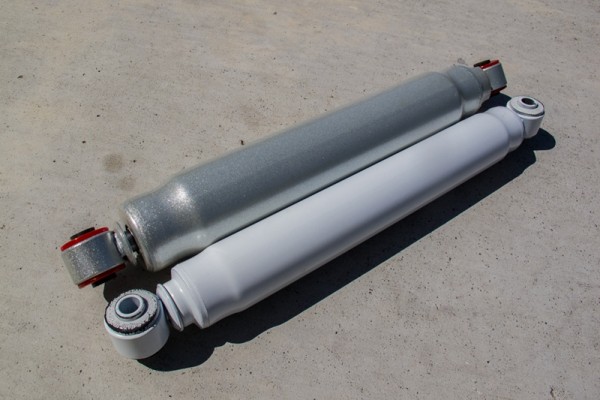The days of neon shock boots and four shocks per corner are gone.
Now, nearly every application can be controlled with a single shock that is properly valved for the intended purpose. “Control” is really the key word here. A shock’s job is to dampen the motion of the suspension as it compresses and extends. Without shocks, our vehicles would bounce down the road like a slinky down a flight of stairs.
“Intention” is the other piece of the puzzle. A shock designed for desert racing will be harsh on the street, and a street-biased shock will bottom out if flogged for hours in the desert. Like choosing a camshaft or intake manifold with a specified RPM range, choosing shocks can be a compromise that requires you to be realistic about your needs. But how do you determine what you need? Let’s take a closer look at shock construction and how it translates into how a shock will perform.
Shock bodies are a lot like human bodies; they come in all shapes and sizes. All shocks use oil, nitrogen gas, or a combination of the two. They also have a shaft that connects to a fixed point on the chassis and a body that mounts to the suspension (or vice versa). Some shocks can be mounted in either orientation (body up or body down) while others must be mounted in a specified orientation. At the end of the shaft, riding inside of the shock body, is a piston that moves as the suspension cycles. How the piston reacts is an exacting science that affects the ride characteristics of the shock.
Rancho offers three different shock models that are useful to illustrate how all of these elements affect a vehicle’s ride characteristics. Rancho has been in the shock business for over six decades; all of its shocks are made in the USA and come with a lifetime warranty.
Rancho RS5000 Shock
The Rancho RS5000 is the standard by which most other 4×4 shocks are measured.
This shock is standard with most Rancho lift kits, and is stock equipment on off-road oriented trucks like the Z71 Chevy Silverado. The RS5000 uses twin-tube construction, with a piston that travels through shock oil in the inner tube and a gas chamber filled with nitrogen in the outer tube. This outer tube offers an added layer of protection should the shock body get dented. The two tubes are connected at the end of the shock body by a valve that allows the oil into the outer tube as the shock compresses.
Rancho RS7000MT
The newest offering from Rancho is the RS7000MT. This shock has a monotube design; instead of an outer tube with nitrogen, there is a second piston inside the shock body that is not connected to the shaft (called a floating piston). On one side of this piston is the shock oil, and on the other side is high pressure nitrogen. Because of the packaging, you get a little less shock travel out of a given shock length when compared to an RS5000, but high pressure monotube shocks generally provide better heat dissipation than twin-tube shocks. This is important, because as suspension energy is dissipated by the shock it is transferred into heat. The harder you work your shocks, the hotter they get. Long washboard roads are the sort of situation where the RS7000MT’s ability to dissipate heat will shine.
Rancho RS9000XL
At the top of the Rancho shock food chain is the RS9000XL. Remember our analogy to camshafts and engine powerbands? The RS9000XL is a twin-tube shock that uses a spring loaded check ball at the base of the shock where the inner and outer tubes connect. There is a nine-position knob on the shock body that allows the compression damping to be changed from “floating like a Cadillac” to “corner like a Corvette” with a simple twist. Also, the latest “XL” Rancho 9000s use a large 2.75-inch shock body that provides more volume for the shock oil and nitrogen. This helps the shock run cooler, but the tradeoff is that the larger shock body can be tricky to fit in tight applications.
Each of these Rancho shocks is available in a variety of lengths and with different mounting options to fit a wide range of applications. If you don’t have the cash for a set of 9000XLs when purchasing your lift kit (and tires, and wheels, and…) or your vehicle use changes—say, from a daily driver to a dedicated off-road vehicle—you can always upgrade once funds allow.










There is a need for a serious revision to this whole article (a lot of misinformation). A: not all pickups with Z71’s come with “Rancho” shocks. B: As per Rancho, these are NOT real RS5000’s, they are GAS CHARGED MONOTUBE shocks/struts. C: The Rancho RS5000 is in no way the standard by which most other 4×4 shocks are measured. They really aren’t that good of a shock.
All this said, this makes me wonder how much Tenneco paid for this article.
most z71s in Canada came with bilsteins…yellow shocks.. the rs5000s are a glorified monroe shock….
Im not happy with them either
Rancho 5000s are junk. 9000XL are way better. Bilstein makes a great line of shocks too.